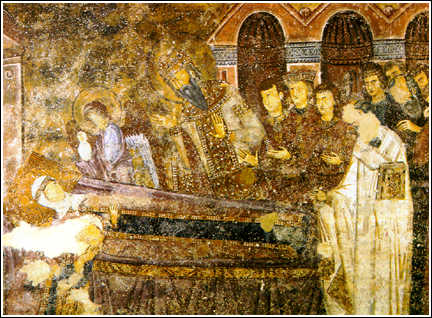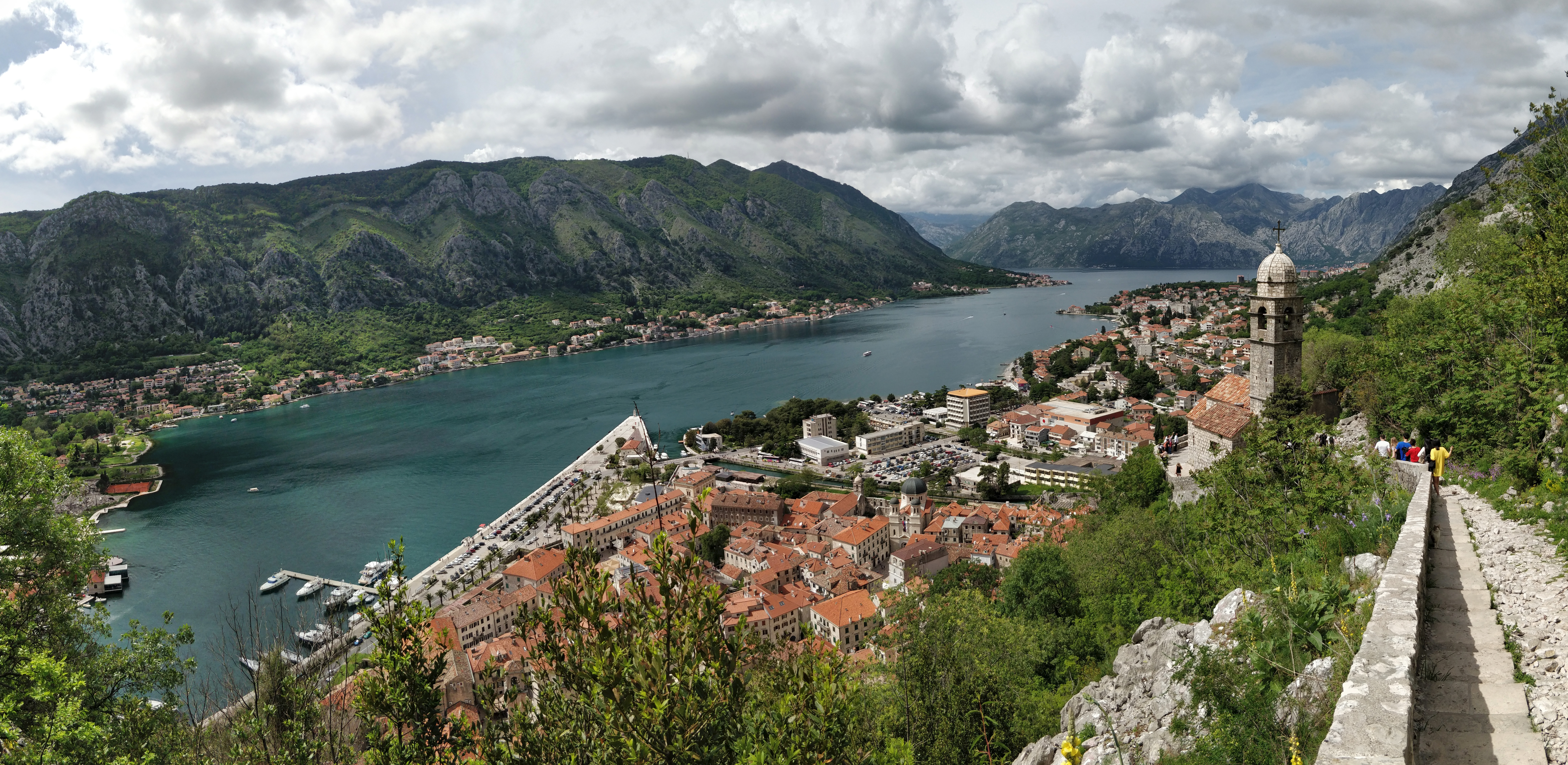|
Anna Dandolo
Anna Dandolo ( sr, Ana Dandolo / Ана Дандоло; 1217–1258) was a Venetian noblewoman who became Queen of Serbia as the third wife of King Stefan the First-Crowned, founder of the Serbian kingdom. She was crowned with Stefan in 1217, and she held this title until his death on 24 September 1228. She was the granddaughter of Enrico Dandolo, Doge of Venice. King Stefan Uroš I was her son. Life Origin Anna was born in Venice, Republic of Venice, on an unknown date, as a member of the House of Dandolo, which ruled in Venice. She was the daughter of Rainero Dandolo, Vice-Doge of Venice, and Procurator of San Marco. Her paternal grandfather was Enrico Dandolo, Doge of Venice, who had earlier made incursions into Zadar (1202) and Constantinople (1204). In 1209, her father was killed in battle against the Genoese during the conquest of Candia. Queen of Serbia In about 1216 or 1217, she married Stefan, the Grand Prince of Serbia and son of Stefan Nemanja, in a magnific ... [...More Info...] [...Related Items...] OR: [Wikipedia] [Google] [Baidu] |
Sopoćani
) , other_names = , image = Manastir Sopocani 2.jpg , caption = Overview of the Sopoćani , order = Serbian Orthodox , established = 1259 - 1270 , disestablished = 1689 , reestablished = 1926 , mother = , diocese = , churches = , founder = King Stefan Uroš I , dedication = Holy Trinity , people = , location = In Novi Pazar, Serbia, near the source of the Raška River in the region of Ras, the centre of the Serbian medieval state. , public_access = Yes , embedded = The Sopoćani Monastery ( sr, / , ), an endowment of King Stefan Uroš I of Serbia, was built from 1259 to 1270, near the source of the Raška River in the region of Ras, the centre of the Serbian medieval state. It is a designated World Heritage Site, added in 1979 with Stari Ras. The monastery is located 15 km west of the town of Novi Pazar. History In the 1160s, the Gre ... [...More Info...] [...Related Items...] OR: [Wikipedia] [Google] [Baidu] |
Dalmatia
Dalmatia (; hr, Dalmacija ; it, Dalmazia; see #Name, names in other languages) is one of the four historical region, historical regions of Croatia, alongside Croatia proper, Slavonia, and Istria. Dalmatia is a narrow belt of the east shore of the Adriatic Sea, stretching from the island of Rab in the north to the Bay of Kotor in the south. The Dalmatian Hinterland ranges in width from fifty kilometres in the north, to just a few kilometres in the south; it is mostly covered by the rugged Dinaric Alps. List of islands of Croatia, Seventy-nine islands (and about 500 islets) run parallel to the coast, the largest (in Dalmatia) being Brač, Pag (island), Pag, and Hvar. The largest city is Split, Croatia, Split, followed by Zadar and Šibenik. The name of the region stems from an Illyrians, Illyrian tribe called the Dalmatae, who lived in the area in classical antiquity. Later it became a Dalmatia (Roman province), Roman province, and as result a Romance languages, Romance culture ... [...More Info...] [...Related Items...] OR: [Wikipedia] [Google] [Baidu] |
Serbian Queens Consort
Serbian may refer to: * someone or something related to Serbia, a country in Southeastern Europe * someone or something related to the Serbs, a South Slavic people * Serbian language * Serbian names See also * * * Old Serbian (other) * Serbians * Serbia (other) * Names of the Serbs and Serbia Names of the Serbs and Serbia are terms and other designations referring to general terminology and nomenclature on the Serbs ( sr, Срби, Srbi, ) and Serbia ( sr, Србија/Srbija, ). Throughout history, various endonyms and exonyms have bee ... {{Disambiguation Language and nationality disambiguation pages ... [...More Info...] [...Related Items...] OR: [Wikipedia] [Google] [Baidu] |
13th-century Serbian Royalty
The 13th century was the century which lasted from January 1, 1201 ( MCCI) through December 31, 1300 ( MCCC) in accordance with the Julian calendar. The Mongol Empire was founded by Genghis Khan, which stretched from Eastern Asia to Eastern Europe. The conquests of Hulagu Khan and other Mongol invasions changed the course of the Muslim world, most notably the Siege of Baghdad (1258), the destruction of the House of Wisdom and the weakening of the Mamluks and Rums which, according to historians, caused the decline of the Islamic Golden Age. Other Muslim powers such as the Mali Empire and Delhi Sultanate conquered large parts of West Africa and the Indian subcontinent, while Buddhism witnessed a decline through the conquest led by Bakhtiyar Khilji. The Southern Song dynasty would begin the century as a prosperous kingdom but would eventually be invaded and annexed into the Yuan dynasty of the Mongols. The Kamakura Shogunate of Japan would be invaded by the Mongols. Goryeo resiste ... [...More Info...] [...Related Items...] OR: [Wikipedia] [Google] [Baidu] |
1264 Deaths
1 (one, unit, unity) is a number representing a single or the only entity. 1 is also a numerical digit and represents a single unit of counting or measurement. For example, a line segment of ''unit length'' is a line segment of length 1. In conventions of sign where zero is considered neither positive nor negative, 1 is the first and smallest positive integer. It is also sometimes considered the first of the infinite sequence of natural numbers, followed by 2, although by other definitions 1 is the second natural number, following 0. The fundamental mathematical property of 1 is to be a multiplicative identity, meaning that any number multiplied by 1 equals the same number. Most if not all properties of 1 can be deduced from this. In advanced mathematics, a multiplicative identity is often denoted 1, even if it is not a number. 1 is by convention not considered a prime number; this was not universally accepted until the mid-20th century. Additionally, 1 is the s ... [...More Info...] [...Related Items...] OR: [Wikipedia] [Google] [Baidu] |
Anna Angelina Komnene Doukaina
Anna Angelina Komnene Doukaina ( el, Ἄννα Ἀγγελίνα Κομνηνή Δούκαινα, sr-cyr, Ана Анђелина Комнина Дукина) was a daughter of Theodore Komnenos Doukas and Maria Petraliphaina. Anna was Queen-consort of Serbia as wife of King Stefan Radoslav. In 1216, Radoslav's father attempted to organize a marriage between his son and Theodora, daughter of Theodore's half-brother Michael Doukas Komnenos Angelos. However, the Church prohibited this marriage because it would have been between cousins of the seventh degree. Instead, Radoslav married Anna shortly after. She was disliked by the Church and the nobility, and considered a corrupting influence on Radoslav - who was already too Greek-influenced in their eyes, as he unconditionally allied himself with Epirus and identified with his mother's Greek dynasty as much as with the Nemanjić. Theodore Doukas Komnenos Angelos was defeated and captured in the Battle of Klokotnitsa with Bulgaria i ... [...More Info...] [...Related Items...] OR: [Wikipedia] [Google] [Baidu] |
List Of Serbian Consorts
This is a list of consorts of Serbian monarchs during the history of Serbia. Middle Ages Princess- and Grand Princess consorts (–1217) Queen consorts Nemanjić dynasty (1217–1365) Empress consorts Nemanjić dynasty (1346–71) Magnate era Mrnjavčević family (1365–95) Lazarević family (1371–1402) Despotess consorts Lazarević dynasty (1402–27) Branković dynasty (1427–59) Kotromanić dynasty (1459) Despotess consorts (in exile) Branković dynasty (1459–1504) Berislavić dynasty (1504–36) Bakić family (1537) Modern Consort of the Grand Leader Karađorđević dynasty (1804–13) Princess consorts Obrenović dynasty (1815–42) Karađorđević dynasty (1842–58) Obrenović dynasty (1858–82) Queen consorts Obrenović dynasty (1882–1903) Queen consort of Serbs, Croats and Slovenes Karađorđević dynasty (1918–29) Queen consorts of Yugoslavia Karađorđević dynasty (1929–45) See also *List of princesses of Serbia Ref ... [...More Info...] [...Related Items...] OR: [Wikipedia] [Google] [Baidu] |
Stephen Uroš I
Stephen or Steven is a common English first name. It is particularly significant to Christians, as it belonged to Saint Stephen ( grc-gre, Στέφανος ), an early disciple and deacon who, according to the Book of Acts, was stoned to death; he is widely regarded as the first martyr (or "protomartyr") of the Christian Church. In English, Stephen is most commonly pronounced as ' (). The name, in both the forms Stephen and Steven, is often shortened to Steve or Stevie. The spelling as Stephen can also be pronounced which is from the Greek original version, Stephanos. In English, the female version of the name is Stephanie. Many surnames are derived from the first name, including Stephens, Stevens, Stephenson, and Stevenson, all of which mean "Stephen's (son)". In modern times the name has sometimes been given with intentionally non-standard spelling, such as Stevan or Stevon. A common variant of the name used in English is Stephan ; related names that have found some curre ... [...More Info...] [...Related Items...] OR: [Wikipedia] [Google] [Baidu] |
Fresco
Fresco (plural ''frescos'' or ''frescoes'') is a technique of mural painting executed upon freshly laid ("wet") lime plaster. Water is used as the vehicle for the dry-powder pigment to merge with the plaster, and with the setting of the plaster, the painting becomes an integral part of the wall. The word ''fresco'' ( it, affresco) is derived from the Italian adjective ''fresco'' meaning "fresh", and may thus be contrasted with fresco-secco or secco mural painting techniques, which are applied to dried plaster, to supplement painting in fresco. The fresco technique has been employed since antiquity and is closely associated with Italian Renaissance painting. The word ''fresco'' is commonly and inaccurately used in English to refer to any wall painting regardless of the plaster technology or binding medium. This, in part, contributes to a misconception that the most geographically and temporally common wall painting technology was the painting into wet lime plaster. Even in appar ... [...More Info...] [...Related Items...] OR: [Wikipedia] [Google] [Baidu] |
Helen Of Anjou
Helen of Anjou ( sr, Јелена Анжујска / Jelena Anžujska, ; c. 1235 – 8 February 1314) was the queen consort of the Serbian Kingdom, as the spouse of King Stefan Uroš I, who ruled from 1243 to 1276. Their sons were later Serbian kings Stefan Dragutin (1276–1282) and Stefan Milutin (1282–1321). As a dowager-queen, she held the provincial governorship in the regions of Zeta and Travunija (until 1308). She built Gradac monastery and was known for her religious tolerance. She is revered as a saint by the Serbian Orthodox Church.Her relics, however, are now lost. Life Origin Helena's origin is not known for certain. Her hagiography, written by Serbian Archbishop Danilo II (1324–1337), states only that she "was of a French family" ( sr, бысть оть племене фpoужьскaаго), while later continuators of the same work noted that her "family was of royal or imperial blood". By the beginning of the 20th century, several genealogical theories on ... [...More Info...] [...Related Items...] OR: [Wikipedia] [Google] [Baidu] |
Stefan Vladislav I
Stefan Vladislav ( sr-cyr, Стефан Владислав, ; – after 1264) was the King of Serbia from 1234 to 1243. He was the middle son of Stefan the First-Crowned of the Nemanjić dynasty, who ruled Serbia from 1196 to 1228. Radoslav, the eldest son of Stefan the First-Crowned, was ousted by the Serbian nobility due to increasing Epirote influence through his marriage alliance to Theodore Komnenos Doukas; thus Vladislav became his successor. He is celebrated as Saint Vladislav by the Serbian Orthodox Church. During Vladislav's reign, his uncle Archbishop Sava went on a pilgrimage and died in Bulgaria while on his way home. Vladislav obtained the remains and buried them in the Mileševa monastery, which he had built intended to be his burial place. Serbia was politically aligned with Bulgaria at the time, since Vladislav was married to Beloslava, the daughter of Ivan Asen II. Vladislav secured Hum, a maritime province under attack by Hungarian crusaders. After th ... [...More Info...] [...Related Items...] OR: [Wikipedia] [Google] [Baidu] |




.jpg)

